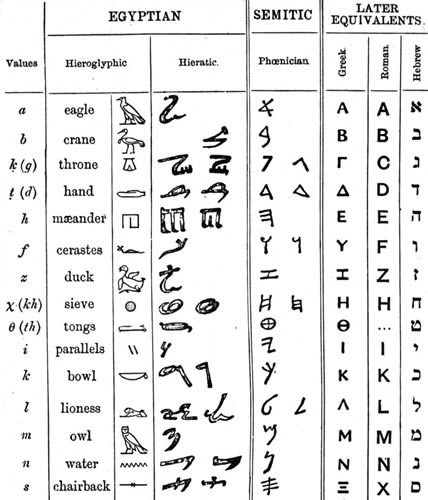Greek Alphabet
The early Greek alphabet was based on the Semitic alphabet of the Phoenicians. It is different from the linear and hieroglyphic scripts preceding it in that each symbol represents a single consonant as opposed to a syllable. The Phoenician alphabet consists of 22 characters with vowel sounds built into the symbols. The Greeks modified the Phoenician alphabet by changing some of the symbols as well as creating separate vowels. They also made their alphabet more phonetically correct.
There are differing accounts of how the Greeks came to use the Phoenician alphabet. Herodotus claims that the Phoenician alphabet was brought by Kadmos to Boiotia where he founded the city of Thebes. Yet the founding of Thebes predates the first uses of the Greek alphabet and so this is seen as a merely fictional explanation. Another account says that the Greek alphabet was actually created by Palimedes, but this view was opposed, even in antiquity, by Hekataios, a sixth century historian. He stated that the Phoenician alphabet was brought over to Greece by Danaos.
The Greek historian Barry Powell believes that the Greek alphabet was created for the purpose of writing down the Homeric verses of the Iliad and the Odyssey. But it is now considered highly likely that a Euboian first adapted the alphabet and from there it was diffused all over Greece. And it is also believed that the alphabet was transmitted from Phoenicia around 800 BCE.
With the invention of the Greek alphabet writing began to be used for a variety of purposes. Whereas Linear B seems to have only been used for inventories and lists, the Greek alphabet was initially used for more literary purposes. Writing became not simply a means of recording events, but also an art form in itself. A well known example of the use of this new alphabet is the inscription on Nestor’s Cup. The most common use of the alphabet however was for votive purposes, such as the dedication of items to certain gods. It was not for another 100 years after the invention of the Greek alphabet that it seems to have been used for administrative or governmental purposes. The first example of this is the stone inscribed with a law from Dreros on Crete which dates to ca. 650 BCE. This law regulates the terms of the town magistrate. After this time the Greek government commonly used the alphabet as a means of disseminating knowledge of laws and decrees. It was also used on items such as coins and boundary stones, like those at the Agora in Athens.

Phoenician and Greek alphabet comparison
Sources
Powell, Barry B. Homer and the Origin of the Greek Alphabet. Cambridge: Cambridge University Press, 1991.
Whitley, James, The Archaeology of Ancient Greece. Cambridge: Cambridge University Press, 2001.
Woodard, Roger D. Greek Writing from Homer to Knossos. New York: Oxford University Press, 1997.
Posted at Dec 13/2007 11:18PM:
Harry Anastopulos: This is a real testament to the amount of trade and influence that must have been going at this particular place and time between the Greeks and the East...these points of contact allow for much trading of culture, ideas, and innovation as well.
